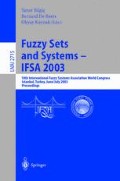Abstract
Since crisp relations are too poor to represent the human way of reasoning, we often use fuzzy relations in preference modelling and multicriteria decision support. At the final stage, the decision maker expects a crisp answer to his problems. Many solutions have been proposed to perform this fuzziness dissolution step. In this paper, interval-valued preference structures are used to achieve this goal.
Access this chapter
Tax calculation will be finalised at checkout
Purchases are for personal use only
Preview
Unable to display preview. Download preview PDF.
References
W. Bandler and L. Kohout, Special properties, closures and interiors of crisp and fuzzy relations, Fuzzy Sets and Systems 26 (1988), 317–331.
T. Bilgiç, Interval-valued preference structures, European Journal of Operational Research 105 (1998), 162–183.
B. De Baets, H. De Meyer, and H. Naessens, On rational cardinality-based inclusion measures, Fuzzy Sets and Systems 128 (2002), 169–183.
B. De Baets and J. Fodor, Twenty years of fuzzy preference structures (1978–1997), Belgian Journal of Operations Research, Statistics and Computer Science 37 (1997), 61–82.
_____, Generator triplets of additive fuzzy preference structures, Proc. Sixth Internat. Workshop on Relational Methods in Computer Science (Tilburg, The Netherlands), 2001, pp. 306–315.
J. Fodor and M. Roubens, Fuzzy Preference Modelling and Multicriteria Decision Support, Kluwer Academic Publishers, 1994.
K. Maes, B. De Baets, and J. Fodor, Towards n-ary disjunctive and conjunctive fuzzy normal forms, Proc. Seventh Meeting of the EURO Working Group on Fuzzy Sets (Varenna, Italy), 2002, pp. 297–302.
I.B. Türkşen and T. Bilgiç, Interval valued strict preference with zadeh triples, Fuzzy Sets and Systems 78 (1996), 183–195.
B. Van De Walle, B. De Baets, and E. Kerre, Fuzzy multi-criteria analysis of cutting techniques in a nuclear reactor dismantling project, Fuzzy Sets and Systems 74 (1995), 115–126.
Author information
Authors and Affiliations
Editor information
Editors and Affiliations
Rights and permissions
Copyright information
© 2003 Springer-Verlag Berlin Heidelberg
About this paper
Cite this paper
Maes, K., De Baets, B. (2003). Extracting Strict Orders from Fuzzy Preference Relations. In: Bilgiç, T., De Baets, B., Kaynak, O. (eds) Fuzzy Sets and Systems — IFSA 2003. IFSA 2003. Lecture Notes in Computer Science, vol 2715. Springer, Berlin, Heidelberg. https://doi.org/10.1007/3-540-44967-1_31
Download citation
DOI: https://doi.org/10.1007/3-540-44967-1_31
Published:
Publisher Name: Springer, Berlin, Heidelberg
Print ISBN: 978-3-540-40383-8
Online ISBN: 978-3-540-44967-6
eBook Packages: Springer Book Archive

